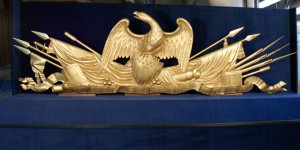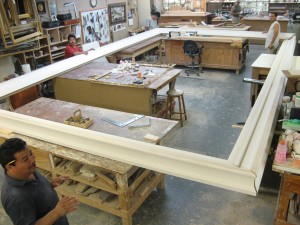 I recently had the pleasure of visiting Eli Wilner & Company’s studio in Long Island City, New York to see an incredible work in progress, the new frame made by the firm for an important American painting, Washington Crossing the Delaware, 1851, by Emanuel Leutze. This painting, the largest of the various versions produced by this German American artist, measures 149 x 255 inches (approximately 12 x 21 feet) and depicts General George Washington proudly leading the charge across the Delaware River to Trenton, New Jersey on December 25, 1776 during the Revolutionary War. The painting and its impressive new frame form part of the Met’s American Wing which is in the process of being totally renovated with the third and final phase of the project scheduled for completion in 2011. The grand opening of the new space took place yesterday in the presence of dignitaries, politicians and the New York elite as First Lady Michele Obama spoke to the crowd as part of her cultural visits around the city. In two years, this grand painting will hang on public view at the completion of the renovation project.
I recently had the pleasure of visiting Eli Wilner & Company’s studio in Long Island City, New York to see an incredible work in progress, the new frame made by the firm for an important American painting, Washington Crossing the Delaware, 1851, by Emanuel Leutze. This painting, the largest of the various versions produced by this German American artist, measures 149 x 255 inches (approximately 12 x 21 feet) and depicts General George Washington proudly leading the charge across the Delaware River to Trenton, New Jersey on December 25, 1776 during the Revolutionary War. The painting and its impressive new frame form part of the Met’s American Wing which is in the process of being totally renovated with the third and final phase of the project scheduled for completion in 2011. The grand opening of the new space took place yesterday in the presence of dignitaries, politicians and the New York elite as First Lady Michele Obama spoke to the crowd as part of her cultural visits around the city. In two years, this grand painting will hang on public view at the completion of the renovation project.
On my visit, gallery director Suzanne Smeaton showed me the maquettes for the final frame along with the crown jewel itself, the frame, which is currently being finished by a team of expert craftspeople at Wilner’s studio. Smeaton explained that the painting had until recently been framed with a simple gold frame, but that in the course of researching the painting curators discovered a nearly 150 year old photograph of the painting which revealed a prior, more complex and patriotic frame – a frame with an elaborate carved eagle, arrows and flags atop the frame and four shields at the inside corners. Metropolitan Museum curators hired Eli Wilner & Company to recreate the frame as it looked in the old photograph. Master carver Felix Teran described this frame as the biggest and best project he may ever have to opportunity to work on, and recalled that it has taken years of work to accomplish this great task. The frame is currently propped up on work tables, and when I visited three craftsmen were inside the center of the enormous wooden piece, a sculpture in itself, hard at work. 
Seeing this three-part example (the old photograph, the plain frame that had been on the painting in recent years, and the reproduction frame in progress) points out some of the more intricate issues of framing and artwork conservation. While curators are often insistent upon accurate, period frames to accentuate the pictures within, there are always changes made over time to frames and collections. Ms. Smeaton points out that as tastes and museum exhibition programs change, records are not always kept of the changes made to frames on paintings and the reasons behind those decisions. We may never know, for example, what ever became of the original eagle frame.
I am looking forward to the day I see the frame on view with its painting which is itself in conservation during the building renovation. It should be a perfect match.
(Photographs courtesy of Eli Wilner & Company)
